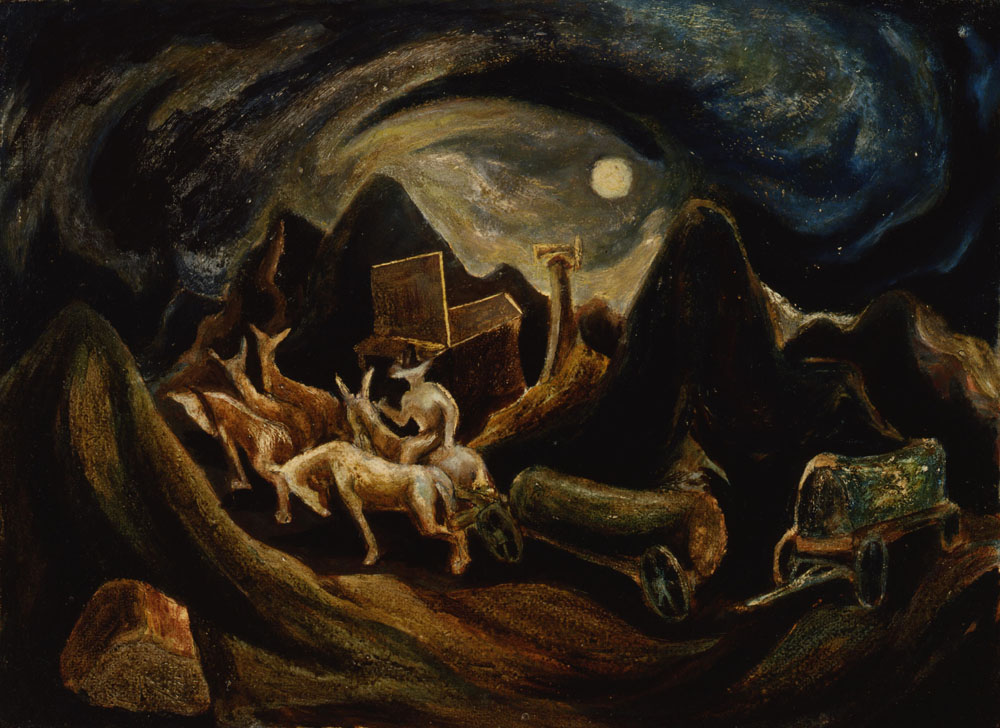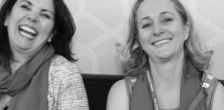I got up close and squinted.
I could make out the figure of a man, pushing his tired horses through a mountain pass on a moonlit night under starry skies.
If anything, it looked like it could have been a Van Gogh.
Anyone but Jackson Pollock.
And then Murray piped up: “Wow! Even someone as unmistakable as Jackson Pollock didn’t start out Jackson Pollock!”
That thought struck me, so that night I dug deeper into Jackson Pollock’s life…
And what I learned has completely shifted the way we market our business.
Jackson Pollock painted “Going West” in 1934. It was a solid work of art that’s still exhibited today, but it could have been painted by any talented artist of his generation… There was nothing about it that screamed Jackson Pollock…
And then, lightning struck.
Barely two years later, Pollock was introduced to liquid paint at an experimental art workshop led by the Mexican muralist David Alfaro Siqueiros and he immediately started painting in completely new ways. He stopped using an easel and brush like he had been taught. He started laying his gigantic canvases out on the floor, using the force of his whole body to paint, dripping and pouring paint from all directions…
And, eventually, he perfected the “big drip technique” he’s become famous for.
Canvases from his “drip” period are unmistakable. You instantly know it’s a Jackson Pollock from across the room, without seeing his signature or the tag on the wall. It’s him.
Moving From “Copycat” You to Truly You
So what this revealed to Murray and me is that even the greatest artists, the greatest marketers, began by being inspired by those who went before them. It’s the whole “shoulders of giants” thing and it’s part of the learning process in any field from art to marketing.
Chances are, you’re in that phase right now. I like to call it “socialized marketing” and it’s where you play “by the book”, do what other people in your industry are doing and follow the “rules.” (You gotta know the rules before you break them, right? 😉
Yes, it’s possible to achieve a solid level of success by employing the strategies, tactics & voice of your competition or your mentors, but what we want most dearly is to hear you speak with a voice that’s yours and yours alone.
If you want to become a thought leader or an authority or spark a vibrant movement for growth, change & transformation, then the market needs something extra. Something more. Something new.
That’s when you throw out the rules you’ve been following and strike out in your own direction.
And that can only happen when you decide to make the leap from “copycat” you to being truly you.
So let’s go back to Jackson Pollock for a moment, talking about his unique process:
My painting does not come from the easel. I prefer to tack the unstretched canvas to the hard wall or the floor. I need the resistance of a hard surface. On the floor I am more at ease. I feel nearer, more part of the painting, since this way I can walk around it, work from the four sides and literally be in the painting.
I continue to get further away from the usual painter’s tools such as easel, palette, brushes, etc. I prefer sticks, trowels, knives and dripping fluid paint or a heavy impasto with sand, broken glass or other foreign matter added.
When I am in my painting, I’m not aware of what I’m doing. It is only after a sort of ‘get acquainted’ period that I see what I have been about. I have no fear of making changes, destroying the image, etc., because the painting has a life of its own. I try to let it come through. It is only when I lose contact with the painting that the result is a mess. Otherwise there is pure harmony, an easy give and take, and the painting comes out well. — Jackson Pollock, My Painting, 1956
Let me repeat: “When I am in my painting, I’m not aware of what I’m doing… I have no fear of making changes, destroying the image, etc., because the painting has a life of its own. I try to let it come through.”
Which brings me to…
The Four Stages of Competence
You’ve probably heard of these. They’re the stages we all pass through on our way to becoming masterful at something.
The third stage — “Conscious Competence” — is where, oftentimes, the “copycat” version of you lives. It’s the stage where you know how to do something, but it takes some amount of thought & concentration.
After that, after you’ve done something so much that the skill becomes second nature with no conscious thought required, you transcend and make the leap to the 4th stage — “unconscious competence.” It’s only in this stage that your true voice can emerge.
At some point in his career between “Going West” and “Drip”, Pollock made the leap from “copycat” to an unmistakable voice and he found he could stop “thinking” about painting and instead, fully drop into the moment and truly “play”, pouring and dripping and experimenting.
Three Ways to Make the Quantum Leap
So how do you make the quantum leap to truly you?
1. Do your “10,000 Hours”.
Clearly, first way is through practice. You may have heard that it takes 10,000 hours to achieve mastery in a new skill.
Yes, while it’s true that mastery takes practice, I believe there are 2 ways to shortcut this process:
2. Creative “Cross-Pollination”.
I’m a huge believer in finding inspiration outside your field and allowing the insights, strategies, solutions and processes of another industry to inform your work.
I regularly draw inspiration from art, literature, filmmaking and technology, and combine that inspiration with what I know about my industry — just like in this blog post.
This kind of lateral thinking or creative cross-pollination can lead to massive breakthroughs and innovations. Many of the most successful technology companies out there regularly send their designers overseas to bathe in new cultures and fresh perspectives to draw inspiration and think thoughts they never could have come up with at home.
That’s why I love changing locations, going to shows & exhibits, and taking my work on the road. It’s also why, when I lead my clients through a branding process, we create a swipe file of magazine clippings and photographs that capture the look and feel of their brand.
I encourage them to pull inspiration from wildly different sources – from architecture to the animal kingdom – because you never where the seed of your true voice will come from.
Pollock cultivated the style that made him famous through learning about liquid paint, Native American sand painting and seeing the work of Ukrainian American artist Janet Sobel.
So be open to new insights and ways of doing things.
Be open to being influenced.
And most importantly, be open to breaking the rules in your industry and doing things different, what I call “post-socialized marketing”.
3. Get a Mentor
Just like Jackson Pollock was introduced to liquid paint at a workshop lead by David Alfaro Siqueiros, one of the fastest ways to progress through The Four Stages of Competence is by finding a mentor, studying everything they teach, and being open to receive the insight they have for you.
Thank you for allowing me to be your mentor.
—
I have a new series of blog posts and trainings planned for the next month and I invite you to join me on this journey to discover your true voice — the part of you that will be unmistakable in the marketplace.
Remember, the world doesn’t need any more copycat coaches, authors, speakers, consultants and entrepreneurs.
The world needs you to be you.
Love it? Hate it? Let me know...
-
Marissa…you nailed a concept that escapes so many people.
This was great info and opened up a whole new thought process for me…kudos!-
So glad to hear this opened up something for you…
-
-
I’m an abstract expressionist painter, who studied Pollock in the early 60s when I first started, and the painting you show is a good student painting with echoes of Ryder and Kochoska. It’s not as imitative as you imply. He was feeling his way toward an expressionist style that pushed the boundaries of what others had done before.
Just an early stage. Nothing to be ashamed of.-
Hi David! Absolutely, Going West is a great piece of work and there’s no shame whatsoever in early stage works. My idea here is that most people don’t nail their voice — or signature style — right away. And it takes some time and exploration before you hit on it…
-
-
Absolutely! Your email and post caught my eye because I believe our “niche” is that uniqueness we each possess and that is the most important part in delivering our gifts to the world and manifesting our purpose.
-
Totally agreed! I also believe that we can have the most impact by expressing our unique expression, personality and experience in a way that contributes to your clients lives.
-
-
Great post. Looking forward to what’s next!
-
I’ve got more awesome posts coming… 🙂
-
-
Marisa, Thank you for this inspiring read! I feel like it was meant for me to see as it addresses an issue that I have been fighting within myself for the past year. I’ve felt stuck, not knowing where to go from here, being back and forth so many times wondering which direction I should take with my jewelry design business. This makes so much sense for me and really hits the nail on the head. It makes everything so much clearer. Thank you so much!
-
Nice! Clarity is so important and it’s something I’ll be talking about over the next month for sure…
-
-
I could not agree MORE with what you said in this post! My undergrad degree is in fine arts. My grad degree is in Social Work (the management end of it). I think one of the reasons I’ve been so successful as a non-profit consultant is because I actually look at what the for-profit sector is doing, what companies are thriving & how that might apply to the non-profit sector. I’m also not afraid to go outside the box, try new things, make it up as I go along. Because, let’s face it, what the non-profit sector has been doing thus far has yet to eliminate any of the social problems they’re trying to address. So it can’t possibly hurt to try something new, right?!
-
Yes! It’s amazing what you can do when you bring fresh approaches in to a stale industry… 🙂
-
-
“I regularly draw inspiration from art, literature, filmmaking and technology, and combine that inspiration with what I know about my industry.” Marisa Murgatroyd
I chose this statement from your post because it was something that was called my attention. Yes, I did read all of the post but I could see that your statement above is so very important.
Being different is what stands out. Being different is being a winner if you express that difference in the correct way. That is how the great people and places have stood out. I love change and I have always changed through my life. Change is a must in life of business for sure. Times evolve and change is always going to be there whether we like it or not.
That is probably why you have done so well in your business. You alway have new stuff to offer, hang outs, blogs and posts and you keep everything fresh. I love it!
Thanks for being you….. I will tell you that I appreciate everything you do. I wish that I could have training with you. Maybe someday soon. Who knows what is in the future, right?
You are a lovely person. I am so glad I have met you. You have really changed my life in so many ways. I love to read everything your send me. Thanks…………..
Hinda Bartoli




























Leave a Comment